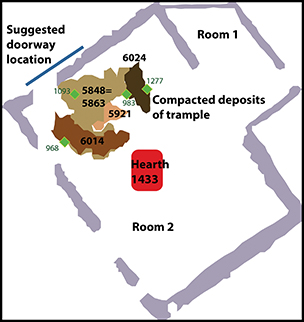Crossref Citations
This article has been cited by the following publications. This list is generated based on data provided by
Crossref.
Aspöck, Edeltraud
and
Banerjea, Rowena Yvonne
2016.
Formation processes of a reopened early Bronze Age inhumation grave in Austria: The soil thin section analyses.
Journal of Archaeological Science: Reports,
Vol. 10,
Issue. ,
p.
791.
Rentzel, Philippe
Nicosia, Cristiano
Gebhardt, Anne
Brönnimann, David
Pümpin, Christine
and
Ismail‐Meyer, Kristin
2017.
Archaeological Soil and Sediment Micromorphology.
p.
281.
Charbonnier, Marie-Caroline
and
Cammas, Cécilia
2018.
Characterization of Gallo-Roman roads in northern France using micromorphological methods.
Quaternary International,
Vol. 483,
Issue. ,
p.
194.
2018.
Reconstructing Archaeological Sites.
p.
233.
Gardner, Tom H.
2019.
Assessing the contribution of integrated geoarchaeological approaches to understand the formation and function of burnt mounds: the example of Hoppenwood Bank, North Northumberland.
Archaeological Journal,
Vol. 176,
Issue. 1,
p.
51.
Nicosia, Cristiano
Ertani, Andrea
Vianello, Alvise
Nardi, Serenella
Brogiolo, Gian Pietro
Arnau, Alexandra Chavarria
and
Becherini, Francesca
2019.
Heart of darkness: an interdisciplinary investigation of the urban anthropic deposits of the Baptistery of Padua (Italy).
Archaeological and Anthropological Sciences,
Vol. 11,
Issue. 5,
p.
1977.
Gutiérrez-Rodríguez, Mario
Goldberg, Paul
Peinado, Francisco José Martín
Schattner, Thomas
Martini, Wolfram
Orfila, Margarita
and
Acero, Charles Bashore
2019.
Melting, bathing and melting again. Urban transformation processes of the Roman city of Munigua: the public thermae.
Archaeological and Anthropological Sciences,
Vol. 11,
Issue. 1,
p.
51.
Brönnimann, David
Röder, Brigitte
Spichtig, Norbert
Rissanen, Hannele
Lassau, Guido
and
Rentzel, Philippe
2020.
The Hidden Midden: Geoarchaeological investigation of sedimentation processes, waste disposal practices, and resource management at the La Tène settlement of Basel‐Gasfabrik (Switzerland).
Geoarchaeology,
Vol. 35,
Issue. 4,
p.
522.
Wouters, Barbora
2020.
A Biographical Approach to Urban Communities from a Geoarchaeological Perspective: High-Definition Applications and Case Studies.
Journal of Urban Archaeology,
Vol. 2,
Issue. ,
p.
85.
Lisá, Lenka
Kočár, Petr
Bajer, Aleš
Kočárová, Romana
Syrová, Zuzana
Syrový, Jiří
Porubčanová, Monika
Lisý, Pavel
Peška, Marek
and
Ježková, M.
2020.
The floor: a voice of human lifeways—a geo-ethnographical study of historical and recent floors at Dolní Němčí Mill, Czech Republic.
Archaeological and Anthropological Sciences,
Vol. 12,
Issue. 6,
Akça, Erhan
Özbal, Rana
Kadir, Selahattin
and
Kapur, Selim
2020.
A petrographic study of selected soils/sediments from sixth millennium BCE levels of the Tell Kurdu site: a contribution to the definition of Technosols.
Archaeological and Anthropological Sciences,
Vol. 12,
Issue. 2,
Macphail, Richard I.
2022.
Encyclopedia of Geoarchaeology.
p.
1.
Grono, Elle
Friesem, David E.
Wood, Rachel
Denham, Tim
Kien, Nguyen Khanh Trung
Kinh, Dang Ngoc
and
Piper, Philip J.
2022.
Site formation processes of outdoor spaces in tropical environments: A micro-geoarchaeological case study from backyard Lo Gach, southern Vietnam.
Archaeological and Anthropological Sciences,
Vol. 14,
Issue. 11,
Häberle, Simone
Deschler-Erb, Sabine
Flück, Matthias
Rentzel, Philippe
Schlumbaum, Angela
and
Vandorpe, Patricia
2023.
“Fine dining” in the Roman provinces: an interdisciplinary study of a peristyle house kitchen at the legionary camp of Vindonissa, Switzerland.
Journal of Roman Archaeology,
Vol. 36,
Issue. 2,
p.
397.





